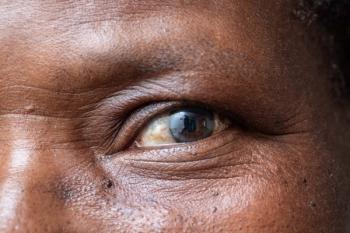
VEGF inhibitor found promising for DME
Montr?al—The exploratory phase II trial of pegaptanib sodium (Macugen, OSI/Eyetech Pharmaceuticals/Pfizer) for the treatment of diabetic macular edema (DME) showed that the drug is safe, effective, and well tolerated. The patients who received the 0.3-mg dose of pegaptanib sodium achieved a better visual acuity level than those who received sham treatment, and they had more of a reduction in the central retinal thickness.
Montréal-The exploratory phase II trial of pegaptanib sodium (Macugen, OSI/Eyetech Pharmaceuticals/Pfizer) for the treatment of diabetic macular edema (DME) showed that the drug is safe, effective, and well tolerated. The patients who received the 0.3-mg dose of pegaptanib sodium achieved a better visual acuity level than those who received sham treatment, and they had more of a reduction in the central retinal thickness.
Christine R. Gonzales, MD, reported the results for the VEGF [vascular endothelial growth factor] Inhibition Study in Ocular Neovascularization Clinical Trial Group at the American Society of Retina Specialists meeting in Montréal.
"Pegaptanib sodium seems to improve visual acuity, restore normal retinal architecture, and decrease the need for macular laser treatment in patients with DME, and all with an excellent safety profile. In addition, preliminary data seem to suggest that pegaptanib sodium may have meaningful impact upon proliferative and nonproliferative diabetic retinopathy. Specifically, treatment with pegaptanib sodium seems to lead to a regression in retinal neovascularization and a reduction of the severity of the diabetic retinopathy, as measured by the ETDRS severity grade," Dr. Gonzales said.
"The patients who were treated with pegaptanib sodium overall did better than those assigned to sham treatment. The results in the 0.3-mg treatment group reached statistical significance (p = 0.02, p = 0.01, and p = 0.003, respectively) for greater than 0, one or more, and two lines or more lines of vision gained. In fact, 73% of the patients who received the 0.3-mg dose had stable or improved vision compared with 23% of patients whose vision was stable or improved in the sham-treatment group. Almost 20% of patients in the 0.3-mg dose group gained more than three lines of vision at the 36-week examination," Dr. Gonzales reported.
Anatomic benefits noted
She also pointed out that there were anatomic benefits associated with treatment with pegaptanib sodium. The mean central retinal thickness decreased significantly (p = 0.021) in the patients who received the 0.3-mg dose of pegaptanib sodium compared with the patients who received sham treatment. The central retinal thickness decreased by a mean of 68 μm in the patients treated with the 0.3-mg dose compared with an increase in mean retinal thickness of 3.7 μm in the sham-treatment group.
"The 1-nd 3-mg dose groups also demonstrated positive trends with regard to the endpoints studied when compared with the control group," she said.
Dr. Gonzales showed fundus photographs and the angiogram from one patient with anatomic and functional benefits that resulted from treatment with pegaptanib sodium. The visual acuity improved from 20/50 to 20/25 and a substantial decrease in macular edema as the result of four injections of the 0.3-mg dose.
Almost 50% of the patients who underwent sham treatment were also treated with laser during the trial compared with 25% of the patients who were assigned to the 0.3-mg dose of pegaptanib sodium.
"Based on these results, it appears that pegaptanib sodium may reduce the need for focal or grid laser treatment," she stated.
Some patients in the study had neovascularization when they were enrolled in the study, and there was evidence of regression of the neovascularization in many of the patients treated with pegaptanib sodium.
Newsletter
Don’t miss out—get Ophthalmology Times updates on the latest clinical advancements and expert interviews, straight to your inbox.



















































.png)


